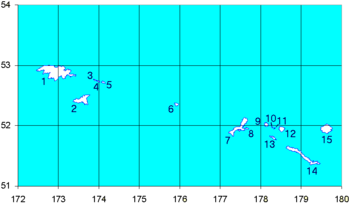Rat Islands: Difference between revisions
coordinates inline are staggeringly boring and unnecessary. coordinates at the top are useful. |
citation |
||
| Line 8: | Line 8: | ||
The name ''Rat Islands'' is the English translation of the name given to the islands by Captain [[Fyodor Petrovich Litke]] in 1827 when he visited the Aleutian Islands on a voyage around the world. The islands are named so because rats were accidentally introduced to Rat Island in about 1780.<ref>http://www.loe.org/shows/segments.htm?programID=09-P13-00029&segmentID=5</ref> {{As of|2009}}, after a government-funded eradication program, Rat Island is believed to be rat-free;<ref>{{cite news| url=https://www.reuters.com/article/2009/06/12/us-alaska-rat-idUSTRE55B66920090612 | work=Reuters | title=Alaska's Rat Island rat-free after 229 years | date=12 June 2009}}</ref> it was renamed Hawadax Island in 2012. However, a post-operation assessment found that many of the local bird populations that the operation was designed to aid were negatively impacted—there was a far higher-than-expected nontarget mortality.<ref>The Ornithological Council, "[http://www.seabirdrestoration.org/pdf/RatIslandReview.pdf The Rat Island Rat Eradication Project: A Critical Evaluation of Nontarget Mortality]", 2010.</ref> An internal [[U.S. Fish and Wildlife Service]] Office of Law Enforcement investigation revealed that several laws may have been violated.<ref>U.S. Fish and Wildlife Service, "[https://drive.google.com/file/d/0BwdOUBgcb_baeXlYTzZ0X05hWFU/view?usp=sharing Report of Investigation: Rat Island Mortality]", 2010.</ref> |
The name ''Rat Islands'' is the English translation of the name given to the islands by Captain [[Fyodor Petrovich Litke]] in 1827 when he visited the Aleutian Islands on a voyage around the world. The islands are named so because rats were accidentally introduced to Rat Island in about 1780.<ref>http://www.loe.org/shows/segments.htm?programID=09-P13-00029&segmentID=5</ref> {{As of|2009}}, after a government-funded eradication program, Rat Island is believed to be rat-free;<ref>{{cite news| url=https://www.reuters.com/article/2009/06/12/us-alaska-rat-idUSTRE55B66920090612 | work=Reuters | title=Alaska's Rat Island rat-free after 229 years | date=12 June 2009}}</ref> it was renamed Hawadax Island in 2012. However, a post-operation assessment found that many of the local bird populations that the operation was designed to aid were negatively impacted—there was a far higher-than-expected nontarget mortality.<ref>The Ornithological Council, "[http://www.seabirdrestoration.org/pdf/RatIslandReview.pdf The Rat Island Rat Eradication Project: A Critical Evaluation of Nontarget Mortality]", 2010.</ref> An internal [[U.S. Fish and Wildlife Service]] Office of Law Enforcement investigation revealed that several laws may have been violated.<ref>U.S. Fish and Wildlife Service, "[https://drive.google.com/file/d/0BwdOUBgcb_baeXlYTzZ0X05hWFU/view?usp=sharing Report of Investigation: Rat Island Mortality]", 2010.</ref> |
||
The Rat Islands are |
The Rat Islands are earthquake-prone as they are located on the boundary of the Pacific and North American tectonic plates.{{citation needed|date= March 2018}} The [[1965 Rat Islands earthquake]] was one of the largest in recorded history with a magnitude of 8.7.<ref>''20 Largest Earthquakes in the World'', [[United States Geological Survey]]. https://www.usgs.gov/natural-hazards/earthquake-hazards/science/20-largest-earthquakes-world</ref> |
||
==References== |
==References== |
||
Revision as of 13:38, 13 March 2020
51°47′17″N 178°18′10″E / 51.78806°N 178.30278°E


The Rat Islands (Aleut: Qax̂um tanangis[1], Russian: Крысьи острова) are a group of volcanic islands in the Aleutian Islands in southwestern Alaska, between Buldir Island and the Near Islands group to its west, and Amchitka Pass and the Andreanof Islands group to its east. The largest islands in the group are, from west to east, Kiska, Little Kiska, Segula, Hawadax or Kryssei, Khvostof, Davidof, Little Sitkin, Amchitka, and Semisopochnoi. The total land area of the Rat Islands is 360.849 sq mi (934.594 km2). None of the islands are inhabited.

The name Rat Islands is the English translation of the name given to the islands by Captain Fyodor Petrovich Litke in 1827 when he visited the Aleutian Islands on a voyage around the world. The islands are named so because rats were accidentally introduced to Rat Island in about 1780.[2] As of 2009[update], after a government-funded eradication program, Rat Island is believed to be rat-free;[3] it was renamed Hawadax Island in 2012. However, a post-operation assessment found that many of the local bird populations that the operation was designed to aid were negatively impacted—there was a far higher-than-expected nontarget mortality.[4] An internal U.S. Fish and Wildlife Service Office of Law Enforcement investigation revealed that several laws may have been violated.[5]
The Rat Islands are earthquake-prone as they are located on the boundary of the Pacific and North American tectonic plates.[citation needed] The 1965 Rat Islands earthquake was one of the largest in recorded history with a magnitude of 8.7.[6]
References
- ^ Bergsland, K. (1994). Aleut Dictionary. Fairbanks: Alaska Native Language Center.
- ^ http://www.loe.org/shows/segments.htm?programID=09-P13-00029&segmentID=5
- ^ "Alaska's Rat Island rat-free after 229 years". Reuters. 12 June 2009.
- ^ The Ornithological Council, "The Rat Island Rat Eradication Project: A Critical Evaluation of Nontarget Mortality", 2010.
- ^ U.S. Fish and Wildlife Service, "Report of Investigation: Rat Island Mortality", 2010.
- ^ 20 Largest Earthquakes in the World, United States Geological Survey. https://www.usgs.gov/natural-hazards/earthquake-hazards/science/20-largest-earthquakes-world
Further reading
- Stolzenburg, William (2012). Rat Island: Predators in Paradise and the World’s Greatest Wildlife Rescue. Bloomsbury Publishing. ISBN 9781408825174.
External links
- Rat Islands: Blocks 1138 thru 1145, Census Tract 1, Aleutians West Census Area, Alaska United States Census Bureau
